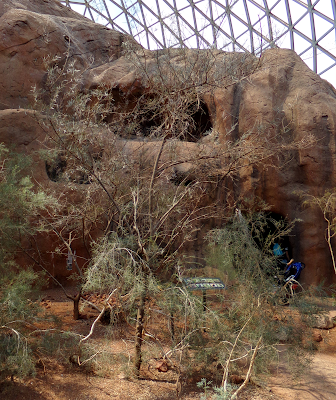 After spending time in the Scott Aquarium at the Henry
Doorly Zoo, I walked to the nearby Desert Dome--The largest indoor desert
habitat in the world. The dome
reaches over 13 stories tall and boasts a diameter of 230 ft. Inside you'll find three subdivisions
of world deserts: The Namib Desert of Southern Africa, The Red Center of Australia
and the Sonora Desert of the southwestern United States. Each features mammals, reptiles, birds
and amphibians. Many are presented
in cage free settings.
After spending time in the Scott Aquarium at the Henry
Doorly Zoo, I walked to the nearby Desert Dome--The largest indoor desert
habitat in the world. The dome
reaches over 13 stories tall and boasts a diameter of 230 ft. Inside you'll find three subdivisions
of world deserts: The Namib Desert of Southern Africa, The Red Center of Australia
and the Sonora Desert of the southwestern United States. Each features mammals, reptiles, birds
and amphibians. Many are presented
in cage free settings.
We're already into the early/mid afternoon and I've only
covered about 20% of the Zoo's foot print.
We'll begin in the Namib Desert area. The dune on the right is made of sand
imported from the actual desert.Here are a couple of wonderful photos of a Klipspringer, Oreotragus oreotragus. Just look at their hooves with the extended "claws", what unique little animals.
In a cave-like passage between biomes, are several reptiles and amphibians. Here a pair of Merten's Water Monitor, Varanus mertensi.
How many Centralian Pythons, Morelia bredii, can you see?
Kookaburra, Dacela novaeguineae, sits in the not-so-old gum tree, as we enter the Australian Red Center Desert.
And above is a beautiful pair of Yellow-footed Rock Wallaby, Petrogale xanthopus.
The final Desert area is dedicated to the flora and fauna of the Sonoran Desert.
This beautiful little was one of so many that call the dome home, but I didn't get its species. And it could be from any of the world regions as it has free flight throughout the dome. It might be a weaver bird from Africa.
Early afternoon was naptime for the Collared Peccary, Pecari taraju.
We end this portion of our visit with a trio of White-faced Coatimundi, Nasua narica.
















No comments:
Post a Comment